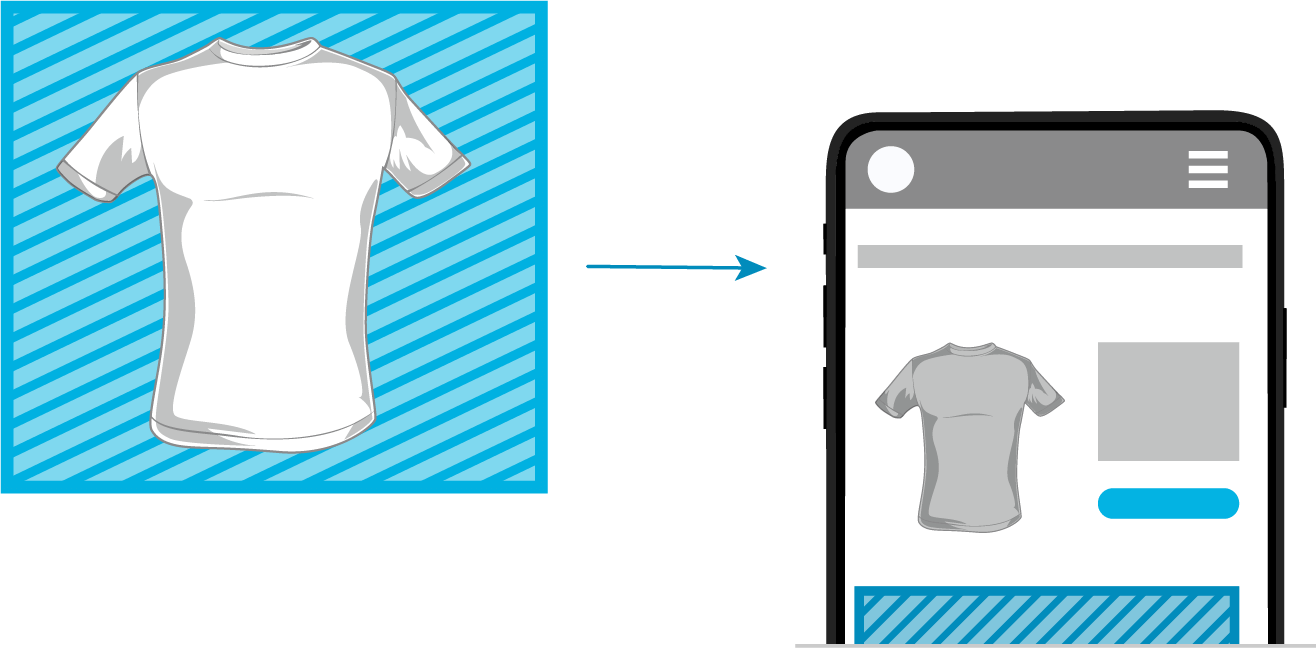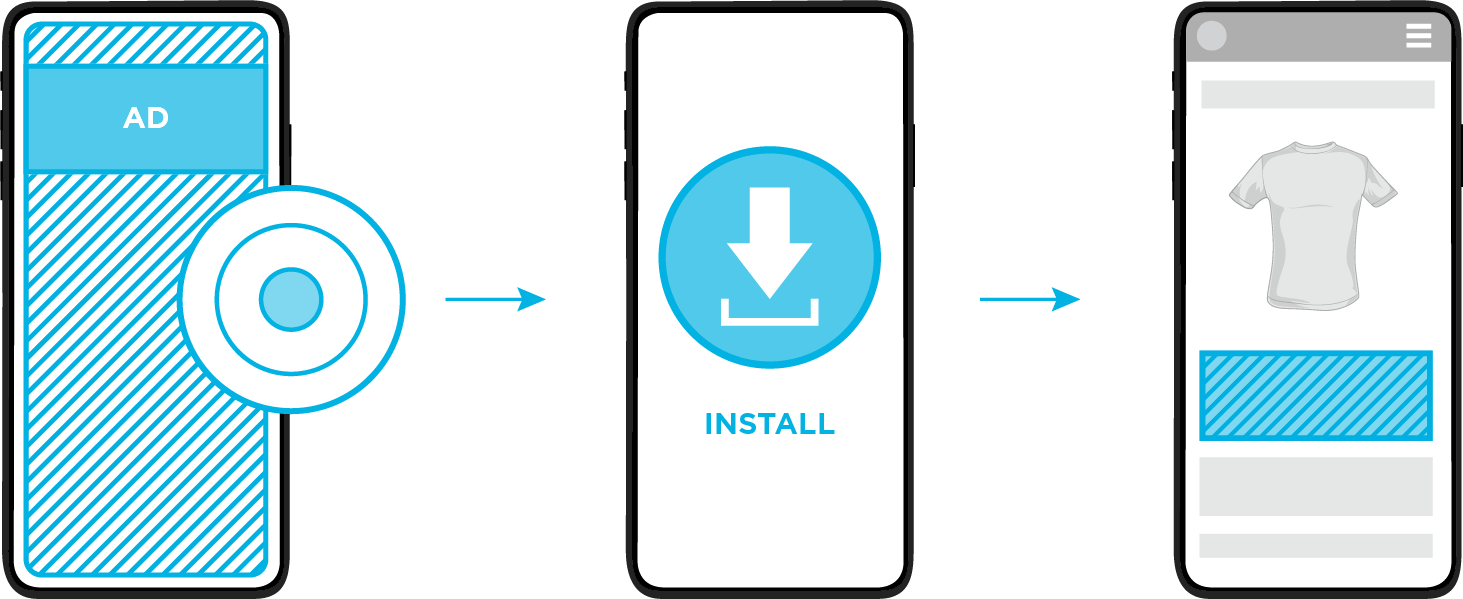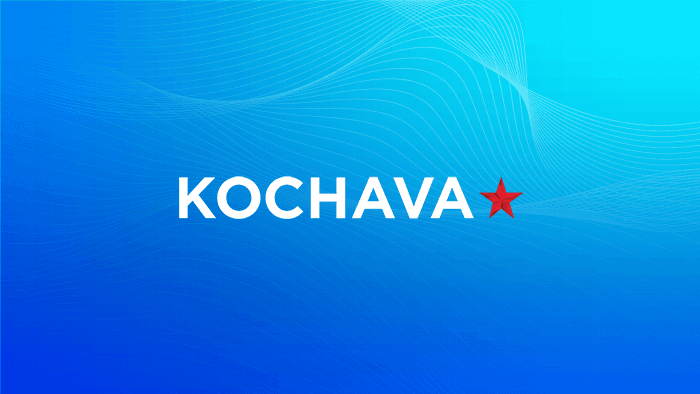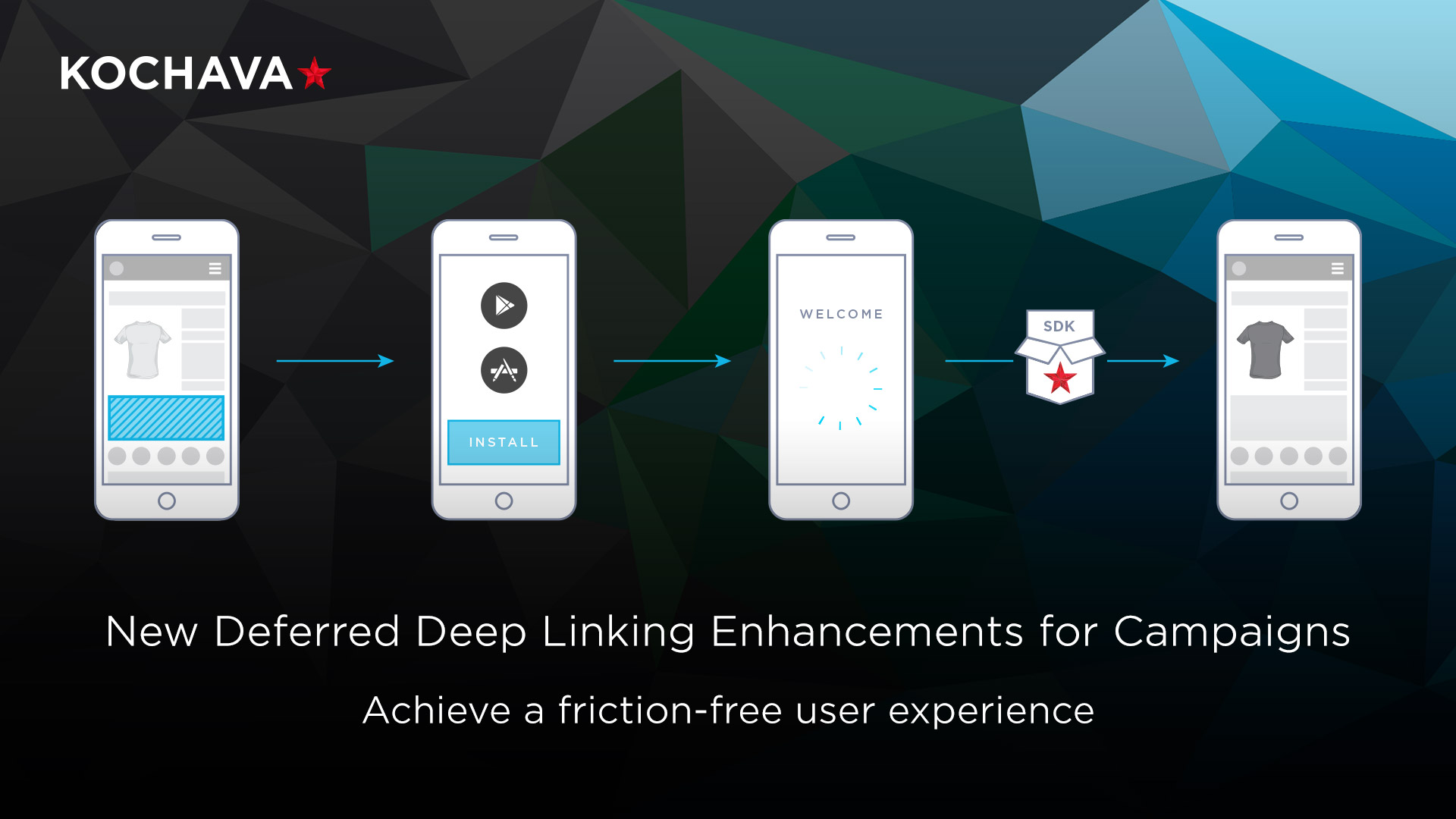Deep Linking | Definition
Deep linking refers to the practice of taking users directly to a specific location or content within a mobile app, rather than to the app’s home screen or a general landing page. Deep links have become an essential mobile marketing tool for creating a seamless, personalized user experience. The ability to launch an app, then navigate to a predetermined in-app destination through deep linking enables direct connections between marketing touchpoints and specific app content. This enhances customer engagement, retention, and conversions by streamlining the mobile user journey.
For marketers, deep links aim to move users directly from an advertisement or call to action (CTA) to the actual point of conversion. Without such a link, a potential customer would have to root around within the app to find what they were looking for. Deep links can also utilize built-in attribution to understand how distinct experiences impact down-funnel engagement and enhance the customer experience. Implementing deep links effectively and tying them to robust attribution and analytics is key to unlocking their full potential.

How Deep Linking Works
Deep links are specialized links that utilize a Uniform Resource Identifier (URI) to send users with the target app already installed on their device directly to a specific location within the app. This is different from regular internet web links, which guide users to individual web pages.
Deep Linking on Mobile Devices
On mobile devices, deep linking is achieved through the use of URI schemes. A typical URI scheme format is myapp://path/to/content, which launches the myapp app, then navigates the user to the specified in-app content location.
URI Schemes
URI schemes are the simplest method of deep linking into mobile apps on iOS and Android operating systems. However, if the user doesn’t have the app already installed, this returns an error and does not redirect the user to the relevant app store. With a deep-linking platform such as Kochava SmartLinks, a developer or marketer can set a fallback destination. For instance, if the user doesn’t have the app installed, they could be routed to the app store page to download the app, or redirected to a mobile web landing page.
Universal Links (iOS)
Universal links are a more advanced deep-linking technology utilized in Apple’s iOS 9+. These connect a set of URLs to relevant in-app locations, automatically redirecting users to the app when they click on a link. This provides a more integrated mobile experience for iOS users.
Android App Links
Similar to iOS Universal Links, Android App Links on Android 6.0+ allow an app to designate itself the default handler of an application’s domain. This verifies that the deep link belongs to the app’s domain and redirects users to either the app or web location depending on whether the app is installed.
These advanced deep linking technologies provide more seamless interplay between mobile web and mobile app experiences.
Cutting-Edge Deep-Linking Technology
Mobile marketers ensure a smooth, seamless journey for users by crafting a cohesive and frictionless digital experience. This involves leveraging responsive creative that optimizes content and functionality across devices—mobile to desktop. Advanced deep-linking technology such as Kochava SmartLinks enables an effortless transition from campaign to content to conversion—whether or not the user has the app installed, regardless of which device or platform they are on.
Importance of Deep Linking in Mobile Marketing
Deep linking has become an essential tool for mobile marketers looking to create a seamless, personalized user experience and drive better campaign results. By enabling direct connections between marketing touchpoints and specific in-app content, deep links can enhance the mobile user journey, improve campaign performance and return on investment (ROI), and increase app discoverability.
Enhancing the Mobile User Experience
Deep links enable marketers to streamline the user journey from an advertisement or call-to-action (CTA) to the actual point of conversion, bypassing the home screen or generic landing pages. This makes it easy for users to find and engage with the information or features that initially drew them to the app. The longer and more obstacle-ridden the journey, the more likely the user is to abandon or fall off before completing the desired action. By personalizing the user journey in this way, deep links can lead to higher conversion rates, improved retention, and increased lifetime value.
Increasing Conversions and Retention
Deep linking enables more granular measurement and attribution, so marketers can understand exactly which campaigns, channels, and touchpoints drive valuable user actions. This visibility empowers optimization, ensuring marketing spend is directed toward the highest-performing initiatives. Additionally, with a smooth user experience made possible by deep links, potential customers are more likely to convert on a desired action, whether making a purchase, signing up for an account, or engaging with an app’s content. Deep links have been shown to double activation and retention rates compared to users who aren’t deep linked.
Increasing App Discoverability
When implemented effectively, deep links can improve an app’s visibility in mobile search results, making it easier for potential users to find and access app content. This increased discoverability translates to more installs and ongoing engagement, further driving the value of mobile marketing efforts.
Enabling Tracking and Measurement
Deep links allow marketers to follow the user journey accurately from initial ad click or referral through to final conversion. This provides granular insights into campaign performance and attribution that can be used to optimize marketing strategies.
By leveraging deep linking throughout the customer lifecycle—from acquisition to retention to re-engagement—mobile marketers can craft a user experience that drives stronger results across key performance metrics. Integrating deep linking into mobile strategy is crucial for maximizing the impact of app marketing.
Types of Deep Links
Deep linking comes in a few different forms, each with its own advantages. Standard or direct deep links take users straight to specific content within an app, but work only if the app is already installed. Contextual deep links go further, not only taking users to relevant content but also capturing data about the user and their preferences to personalize the experience. Deferred deep links address the scenario where the app is not installed yet, first directing the user to the app store to download the app, then taking them to the intended content once the app is installed and launched for the first time. Understanding these types of deep links and how to implement them effectively is key to creating a seamless user experience and driving better app engagement and conversions.
Direct Deep Linking
A standard or direct deep link directs users to a specific part of an app or relevant content when the app is already installed, using the app URL. This is a simple link, but works only if the user already has the mobile app installed; otherwise, it bounces the user out from their app journey.
Contextual Deep Linking
This type of deep link takes a user directly to content they are inclined to show interest in. It is able to pass metadata to help developers and marketers offer a personalized and targeted app experience immediately upon opening the app. A user may be shown a creative ad for a product matching their interests, and this context is passed from the ad server into the deep-link destination, connecting the user directly to the content, product, or experience from the ad engaged with. These links also enable app marketers to gather information on how marketing campaigns and different channels are performing.
Deferred Deep Linking
When a mobile user has an app installed, a deep link takes them directly to the relevant content inside the app. If they don’t have the app installed, a deferred deep link first takes them to the appropriate app store to download the app, then to the specific in-app destination to view the content. Thus, the deep linking is deferred until the application is installed and launched/opened by the user.

Implementing a deferred deep-linking solution with a provider like Kochava enables marketers to give a user the exact same experience upon their first app open after install as if they had been directly deep-linked from the ad.
Use Cases for Deep Linking
Deep linking can be leveraged in a variety of ways to enhance the mobile user experience and drive better engagement and conversions. From enabling cohesive app-to-app connections to providing a frictionless path for the user from marketing channels such as SMS, email, and social media directly into targeted in-app content, deep links can be applied throughout the customer journey. The following use cases highlight how deep linking can be strategically implemented to maximize the impact of mobile marketing efforts.
App-to-App Linking
Deep linking enables users to jump from one app to another, directly to specific content. This creates a continuous user experience between apps and gives users easy access to relevant content in the case of multiple apps.
Mobile Web-to-App Linking
When mobile search engines display results, moving users directly to the specific content within the app via a deep link ensures a better experience by immediately engaging them. Deep links dynamically detect the user’s device and platform, then instantly redirect them to the promoted in-app content.
Desktop-to-App Linking
Deep links can move desktop users directly to mobile app content, ensuring that they remain engaged with the app and encouraging subsequent sessions. For example, Google Maps prompts desktop users to share a deep link that opens directly in the recipient’s mobile app. Additionally, some brands may offer a quick response (QR) code on their website; users scanning it are deep-linked right to the app store product page to get the mobile app.
SMS-to-App Linking
If an app has SMS subscribers, deep links from compelling text messages can drive immediate engagement and app sessions. These might promote an in-app feature, offer a discount, or direct users to other enticing content.
Email-to-App Linking
Email can be effective in re-engaging users. Combining email and deep links ensures that users are alerted and given the ability to reach highly relevant in-app content easily.
Social Media-to-App Linking
Deep links can be used in social media posts and promotions to drive users directly into specific app content or offers rather than to an app’s home screen.
Referrals-to-App Linking
Deep links enable users to share specific content from an app with their social circles via personalized invites. The resulting data can be used to further personalize new users’ onboarding experience and measure new user acquisition through existing user referrals.
Evolution of Deep Linking
The technology behind deep linking existed prior to mobile apps, with the practice taking hold on the traditional web in the late 1990s. While deep links became commonplace on internet websites, deep linking to content and actions within mobile apps proved more challenging. This left the industry needing a simplified solution to drive users directly to specific in-app experiences.
Mobile deep linking found its footing in 2012 as app-to-app connections became more prevalent. Around 2013 and 2014, with mobile commerce exploding and conversion rates skyrocketing, deep linking solutions and tools were improved to meet the industry’s demand for a more seamless way to drive lower-funnel conversions. However, issues around trackability and transparency between click and conversion remained.
In recent years, the continued growth of mobile apps and need for friction-free user experiences have made deep linking an essential part of the mobile marketing toolkit. Innovations such as contextual and deferred deep linking have further enhanced the capabilities of the technology to deliver personalized user journeys and maximize campaign performance.
Future of Deep Linking
As the mobile ecosystem continues to evolve, deep linking is ever-growing in importance. With increased competition for user attention, the ability to provide a seamless, personalized user experience remains critical for driving app engagement, retention, and revenue.
Deep-linking technologies continue to become more sophisticated, enabling even tighter integration between marketing campaigns and in-app experiences. Advances in areas such as contextual deep linking and cross-device tracking will enable marketers to create highly targeted, data-driven campaigns that deliver maximum impact.
Moreover, as privacy regulations become more prevalent and robust, deep linking plays a key role in helping mobile marketers adapt, providing a means to deliver personalized experiences without relying on user data collection.
In summary, deep linking is poised to remain a cornerstone of effective mobile marketing strategies, helping brands cut through the noise and forge stronger, more valuable connections with their customers.
Kochava Deep-Linking Solutions
A successful deep-linking strategy requires the ability to accurately measure outcomes in down-funnel conversions. Working with the right measurement partner can make the process much smoother. With Kochava SmartLinks, deep linking and attribution are unified in one smart package.
Kochava SmartLinks empower marketers to create one tracking link with dynamic routing and deep linking based on the detected platform; one link can be used across iOS, Android, web, and other connected devices. SmartLinks can measure user engagement across paid- and owned-media campaigns for not only acquisition but also reengagement. This provides full-funnel attribution tied back to a precise ad and deep-linking experience.

More Information
Learn how you can track and optimize your entire media mix more efficiently while maintaining a seamless user experience with Kochava’s dynamic deep-linking solutions.
- Video introduction: Deep Linking Solutions by Kochava
- Case study: Mobile Brands
- Google is deprecating Firebase Dynamic Links—and Kochava is ready to help: Learn more
- In-depth guide to deep links, why you need them, and Kochava SmartLinks: Download our free guide



